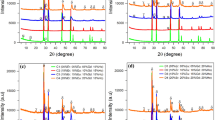Abstract
The massive transformation in metallic alloys has been investigated in considerable detail over the past three decades, both theoretically as well as experimentally. Rapid atomic transport, however, usually makes it difficult to experimentally investigate the kinetics of the massive transformation in metallic alloys under isothermal conditions. In ceramics, on the other hand, diffusion is generally much slower and can be manipulated through defect chemistry by the addition of an aliovalent dopant (that is, a dopant of a valence different from that of the host ion), and/or by altering the atmosphere. This, in principle, makes it possible to investigate the kinetics of the massive transformation in ceramics under isothermal conditions. The present manuscript reports on a study of the massive transformation in Bi2O3-based ceramics. Samples in the Bi2O3-RE2O3 systems, where RE is Y or a rare-earth ion, were fabricated in a dense from by consolidating requisite powder mixtures and sintering compacts in air. The high-temperature form of Bi2O3 is isostructural with CaF2, with 25 pct of the oxygen sites being vacant. This makes it an excellent oxygen ion conductor, thus affording the measurement of oxygen ion conductivity as a technique to investigate the kinetics of the massive transformation. The kinetics of the massive transformation was investigated under isothermal conditions using a number of techniques, including X-ray diffraction (XRD), reflected optical microscopy, transmission optical microscopy, transmission electron microscopy (TEM), electron-probe microanalysis (EPMA), and the measurement of ionic conductivity. The studies demonstrated that the cubic → rhombohedral transformation (during cooling) in Bi2O3-based ceramics is a massive transformation, and the rhombohedral → cubic reverse transformation (during heating) is also a massive transformation. A study of the Gd2O3-Bi2O3 system also showed that a massive transformation occurs inside a two-phase field, thus possibly shedding some light on a controversial point, much debated in the literature on metallic alloys. The sluggishness of the transformation kinetics suggests that ceramic systems are perhaps better suited to investigate salient features of the massive transformation (and, for that matter, many other diffusional transformations), theories for which have been developed for metallic alloys.
Similar content being viewed by others
References
T.B. Massalski: Acta Metall., 1958, vol. 6, pp. 243–53.
J.E. Kittl and T.B. Massalski: Acta Metall., 1987, vol. 15, pp. 161–80.
D.A. Karlyn, J.W. Cahn, and M. Cohen: Trans. TMS-AIME, 1969, vol. 245, pp. 197–207.
E.B. Hawbolt and T.B. Massalski: Metall. Trans., 1970, vol. 1, pp. 2315–22.
T.B. Massalski, A.J. Perekins, and J. Jaklovski: Metall. Trans., 1971, vol. 3, pp. 687–94.
C. Claird and H.I. Aaronson: Acta Metall., 1969, vol. 17, pp. 505–19.
K.R. Kinsman, E. Eichen, and H.I. Aaronson: Metall. Trans. A, 1975, vol. 6A, pp. 303–16.
G. Baro, H. Gleiter, J.H. Perepezko, and T.B. Massalski: Mater. Sci. Eng., vol. 22, pp. 171–76.
S.K. Bhattacharya, J.H. Perepezko, and T.B. Massalski: Acta Metall., 1974, vol. 22, pp. 879–86.
J.H. Perepezko and T.B. Massalski: Acta Metall., 1975, vol. 23, pp. 621–31.
M.R. Plichta and H.I. Aaronson: Acta Metall., 1980, vol. 28, pp. 1041–57.
M. Hillert: Metall. Trans. A, 1984, vol. 15A, pp. 411–19.
N. Nityanand, M.R. Plichta, and H.I. Aaronson: Scripta Metall., 1986, vol. 20, pp. 593–97.
E.S.K. Menon, M.R. Plichta, and H.I. Aaronson: Acta Metall., 1988, vol. 36 (2), pp. 321–32.
B. Johnson: J. Appl. Phys., 1990, vol. 67 (3), pp. 1307–11.
B. Johnson and J. Agren: Acta Metall. Mater., 1990, vol. 38 (3), pp. 433–38.
A.G. Khachaturyan: Theory of Structural Transformations in Solids, John Wiley & Sons, New York, NY, 1983, p. 143.
T.C. Yuan and A.V. Virkar: J. Am. Ceram. Soc., 1986, vol. 70 (12), pp. C310-C312.
J. Chen, Q. Tian, and A.V. Virkar: J. Am. Cearam. Soc., 1992, vol. 75 (4), pp. 809–21.
L.G. Sillen and B. Aurivillius: Z. Krystaogr., 1939, vol. 101, pp. 483–95.
H.A. Harwig: Z. Anorg. Allg. Chem., 1978, vol. 444, pp. 151–60.
H.A. Harwig and J.W. Weenk: Z. Anorg. Allg. Chem., 1978, vol. 444, pp. 161–77.
M.J. Verkerk, K. Keizer, and A.J. Burggraaf: J. Electrochem. Soc., 1973, vol. 3, pp. 65–72.
T. Takahashi and H. Iwahara: Mater. Res. Bull., 1978, vol. 13, pp. 1447–53.
T. Takahashi, T. Esaka, and H. Iwahara: J. Appl. Electrochem., 1972, vol. 5, pp. 197–202.
K.Z. Fung and A.V. Virkar: J. Am. Ceram. Soc., 1991, vol. 74 (8), pp. 1970–80.
P. Su and A.V. Virkar: J. Electrochem. Soc., 1992, vol. 6, 1671–76.
K.Z. Fung, J. Chen, and A.V. Virkar: J. Am. Ceram. Soc., 1993, vol. 76 (10), pp. 2403–18.
K.Z. Fung, A.V. Virkar, and D.L. Drobeck: J. Am. Ceram. Soc., 1994, vol. 77 (6), pp. 1638–48.
P. Su and A.V. Virkar: J. Am. Ceram. Soc., 1996, vol. 79 (2), pp. 371–80.
R.K. Datta and J.P. Meehan: Z. Anorg. Allg. Chem., 1971, vol. 383, pp. 328–37.
P. Su and A.V. Virkar: J. Am. Ceram. Soc., 1999, vol. 82 (8), pp. 2225–32.
Author information
Authors and Affiliations
Additional information
This article is based on a presentation made at the symposium entitled “The Mechanisms of the Massive Transformation,” a part of the Fall 2000 TMS Meeting held October 16–19, 2000, in St. Louis, Missouri, under the auspices of the ASM Phase Transformations Committee.
Rights and permissions
About this article
Cite this article
Virkar, A.V., Su, P. & Fung, KZ. Massive transformation in bismuth oxide-based ceramics. Metall Mater Trans A 33, 2433–2443 (2002). https://doi.org/10.1007/s11661-002-0365-1
Issue Date:
DOI: https://doi.org/10.1007/s11661-002-0365-1




